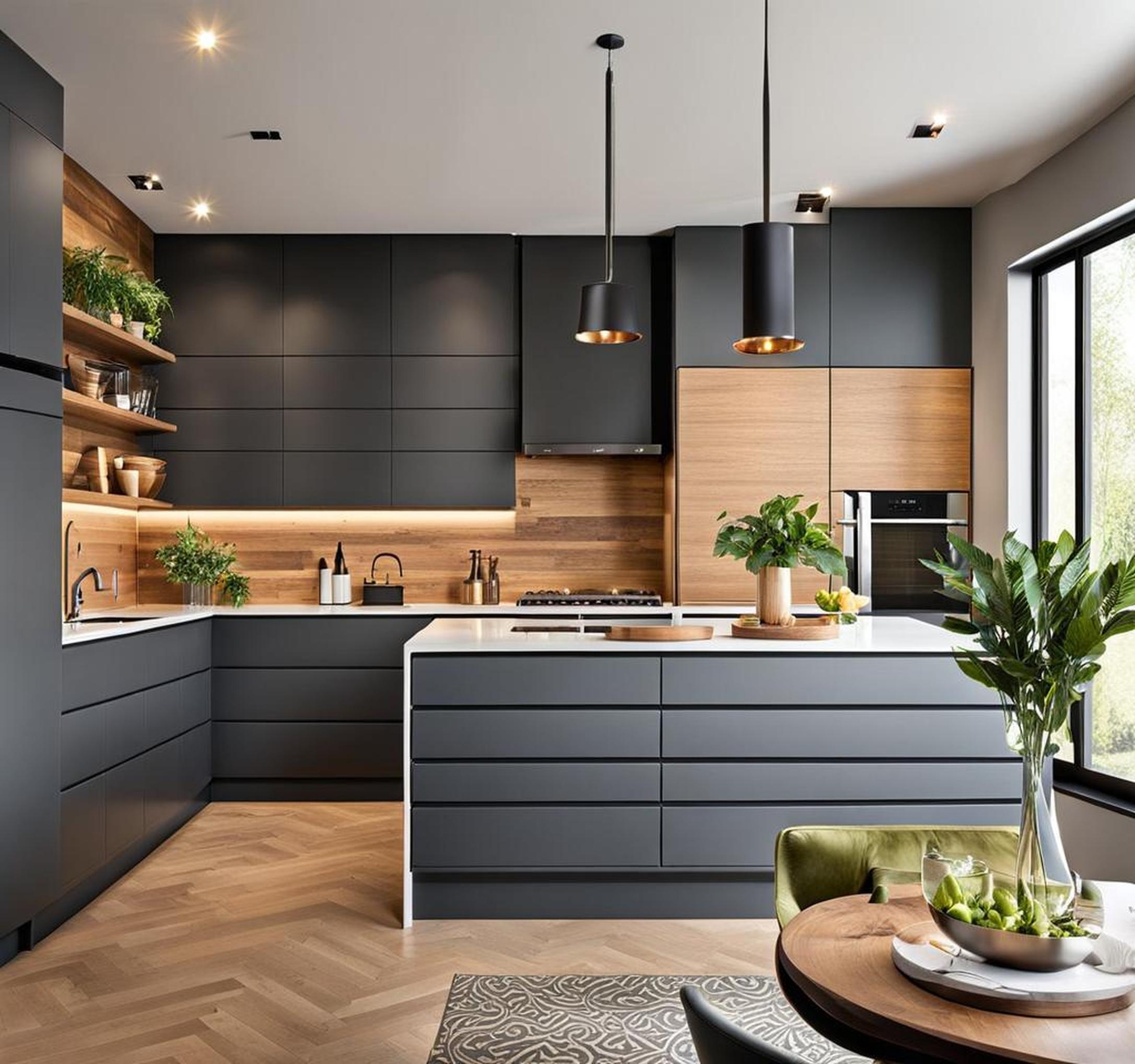An accent wall can take a kitchen from boring to bold by adding a pop of color, texture, or creative material. Unlike painting all four walls, an accent wall lets you experiment with dramatic colors to set a mood without overwhelming a space. Strategically placed accent walls also draw the eye, breaking up plain spaces to become decor focal points. The right kitchen accent wall color or material transforms the room’s aesthetic.
Approach accent walls as an opportunity to showcase your personal style. While white and beige kitchens have clean appeal, a bold accent wall signals sophistication, energetically reflecting the home chef’s confidence and flair. Wood paneling offers rustic warmth contrasting sleek granite. Exposed brick lends industrial edge to a relaxed cottage kitchen. There are endless artistic possibilities.
Benefits of Accent Walls in Kitchens
Beyond adding visual appeal, accent walls offer several advantages:
- Enhances the kitchen’s overall design aesthetic
- Provides depth, dimension, and texture
- Creates a decorative focal point
- Sets the tone or mood with color
Kitchen accent walls cleverly draw the eye, focusing attention on decor you want noticed. For instance, a blue or green wall naturally directs eyes to intricate white cabinetry details. Wood paneling makes marble backsplashes shine brighter. Espresso wallpaper lets an antique kitchen island and pendant lighting steal the show.

Factors to Consider When Choosing a Kitchen Accent Wall
Many design aspects impact accent wall selection. Keep these in mind:
Kitchen Layout and Lighting
An accent wall’s location depends on the room’s size and shape. In a spacious kitchen, use a far-side wall to create depth. For small or narrow galleys, try a short end wall. Near the dining table draws guests’ attention. Consider lighting too. Dark accent walls feel cozier in sunny rooms but can look dreary in dim kitchens.
Existing Kitchen Aesthetics and Materials
The current decor’s color scheme and textures should inform accent wall choices. For cool-toned contemporary spaces with silvery appliances and icy quartz counters, warm wood or coral walls present delightful contrast. In traditional kitchens, an antique brick or floral wallpaper accent wall complements ivory cabinetry and natural stone. Match accent walls to fixtures’ metallic finishes.
Type of Accent Wall Color, Material or Texture
Beyond paint, accent walls highlight alternative materials for stunning effects. Actual wood planks offer rustic warmth. Glossy ceramic tile and weathered bricks add dimension. Textured wallpaper makes a vibrant style statement. While painted drywall is simplest, fabrics like cushioned velvet can soften hard surfaces. Many mediums create accent walls with unique moods.
Personal Style and Preference
Most importantly, kitchen accent walls should showcase personal taste. Intentionally contrast the accent wall with cabinetry and counters to make it pop. While open shelving suits casual spaces, framed accent walls with picture rails fit formal rooms. Reflect style in color too – vivid fuchsias for lively kitchens, soothing sages in zen spaces. There are no wrong choices if you follow your bliss.
Selecting an Accent Wall Color
If using paint, pay attention to accent wall color selection. While neutrals modernize, bright or deep hues make statements. Combining color theory basics with current trends simplifies choosing:
Types of Kitchen Accent Wall Colors
- Cool, neutral shades like airy grays, calming blues and natural taupes effortlessly match existing elements.
- Warm, bright tones like coral, olive green, mustard yellow and burnt orange enliven rooms.
- Dramatic choices like deep charcoal and ebony black create intimate, elegant spaces.
Hues that Coordinate with Specific Aesthetics
Popular pairings include:
- Sage green with natural wood cabinetry and brass fixtures
- Navy blue with marble counters, gold hardware and pendant lighting
- Charcoal grays to contrast all-white contemporary spaces
Paint Color Options: Sheens, Finishes and Effects
Beyond the accent wall color itself, sheens interplay with lighting. Flat or matte paint absorbs light, muting color. The velvety look suits muted hues. Eggshell offers subtle glow, ideal for large accent walls. Satin sheens reflect more light, intensifying color. It works in both bold and subdued palettes. Semi-gloss paints have brilliant sheen, pairing well with dark shades. Specialty finishes like metallic paint, crackled glazing, or lime-wash effects present further options for customization.
Bringing It All Together with Complementary Decor
An accent wall serves as the starting point to build a cohesive kitchen decor theme. Incorporate accent wall colors throughout design details. Paint ceiling beams or open shelves in matching hues. Consider pendant lights or barstools with colors and materials echoing the statement wall. For example, introduce wood and blue accents like wooden barstools and navy window treatments to reinforce a navy accent wall. Layer textures matching those on the accent wall through countertop materials, backsplashes, or dining furniture. Kitchen accent walls let imagination shine.
Navy Blue Accent Wall
Navy blue is a popular choice for kitchen accent walls due to its versatility and ability to create a sophisticated and timeless look. It pairs well with natural wood tones, brass fixtures, and white or light-colored cabinets. Navy blue also adds depth and richness to a kitchen space.
Red Accent Wall
A bold red accent wall can add a pop of energy and excitement to a kitchen. It’s perfect for those who want to make a statement and create a focal point. Red pairs well with white cabinets, stainless steel appliances, and natural wood accents.
Green Accent Wall
Green is a calming and refreshing color that can add life to a kitchen space. A green accent wall can create a peaceful and tranquil atmosphere. Green pairs well with natural wood tones, white or gray cabinets, and brass fixtures.
A yellow accent wall can add warmth and brightness to a kitchen space. It’s perfect for those who want to create a cheerful and sunny atmosphere. Yellow pairs well with white cabinets, natural wood accents, and stainless steel.
